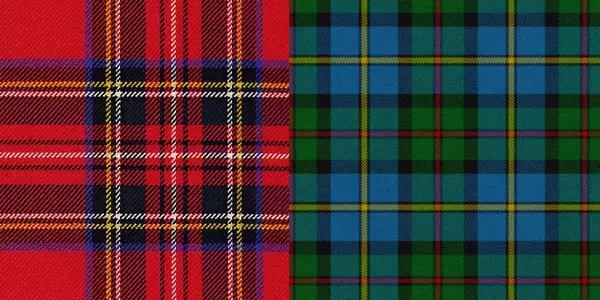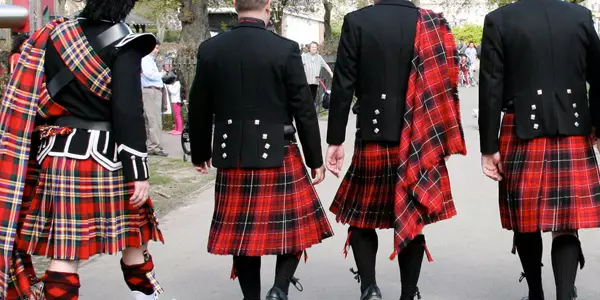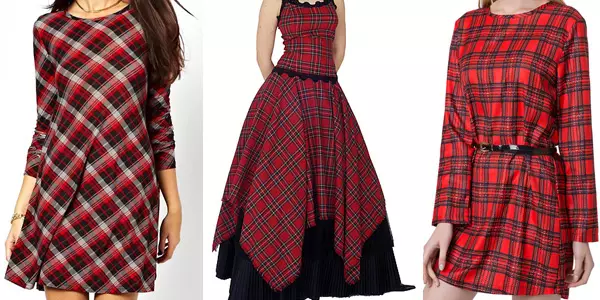The fabric into the cell does not come out of the fashion for more than two centuries. Of the variety of checkered materials, the cloth is especially highlighted by the tissue of the Scotland, whose name directly indicates the country of its origin. The second, and more accurate name of this material - Tartan - immediately refers us to the era of historical novels and movies, when the cell of a certain species and color was a kind of passport of every resident of Scotland.

Tartan and his story
It was established that the method of manufacturing a checkered wool fabric was known for the Scots of more than two thousand years ago. The origin of the word "Tartan" historians are explained in different ways, producing it from the Starofranzuz "fabric", as well as the Gaelian "color of the area" or "cross-crosswise". The latter name is explained by the fact that the Scotland is manufactured in the way of a sanching weave from pre-painted threads, located crosswise.
The colors and complexity of the pattern directly indicated the status of a person. The poorest wore only one-photon dark clothing, the Royal Tartan contained seven colors. As a rule, sheep wool was painted with natural means, and their choice pointed to the locality, from where Tartan and his owner came from. Bright blue, green, and especially the red colors were the accessory of the highest class. In addition, bright shades were characteristic of solemn and combat clothes, and a darker cell was used (and used) for hunting costumes.
Over time, Tartan has a certain colors has become a sign of accessories to a particular clan. True, it concerned only men who wore a heavy and warm checkered quilt, which until the XVIII century was a combination wrapped around the belt of a swing skirt into a fold and thickened on the shoulders of the raincoat. Women, as a rule, dressed in a monophonic fabric of bright or bright tones. Over time, in addition to clan tartanov, appeared:
- Personal belonging to the leaders of clans;
- dresses having a bright background and intended for women;
- mourning;
- Military, etc.
Article on the topic: Embossing foil with their own hands on paper and on the skin: technology and materials
In the middle of the XVIII century, after the suppression of the Yakobitsky rebellion, Tartan fell under the ban. The exception was made only for employees of the patrol royal troops, called the "Black Guard". The pattern of their killets to the present refers to one of the most common.

The revival of Scottish traditions occurred at the beginning of the XIX century and is associated with a meeting in Edinburgh King Eduard IV and Walter Scott writer. For the royal house, a special cage was created on a red background, and Tartan, as a symbol of romanticism and freedom and freedom, spread throughout Europe. Checkered Plaid can be seen on the shoulders of Pushkin and the end of the last century, trousers and the vest in the cell were fashionable to afford the male wardrobe. Over time, the Scotland has become one of the favorite materials for everyday female and children's clothing, and even used for shaped dresses in gymnasiums and guesthouses.
What is the Scotland?
Classical Scotland is a woolen fabric with a plaid pattern. To create it, the so-called network is formed on the weaving machine, that is, a set of painted threads. Threads are strict, and intertwined in a straight line, and then reverse sequence. As a result, a basic feature is formed, which distinguishes Tartan from other cellular materials - a cell with a diagonal symmetry, so that the Scotland looks very good with a slant.Especially it should be said about the varieties of traditional ornament, which is customary to register in the World Receiver of Scottish Tartanov (it consists of 33,000 patterns and is closed to replenish) or in the Scottish register of tartanov, where the cell is registered more than 6000 varieties. In addition to the pattern, Tartan is also classified by density, which is measured in ounces per square yard and is from 8 to 16.
As for mass production, cloths made of cotton, artificial and mixtures are also under the category of "Scotland". Often they are manufactured by the method of linen weave, which is applied with a characteristic print. A variety of cells are often applied to knitwear, nonwoven and other materials.
Article on the topic: Belt Crochet: Scheme and Description Accessory on a dress with photos and video
Fashion in cell
It can be argued that the Scottish cell has become a classic fashion. Such a fabric is great for coats, costumes, dresses in style:
- Casual;
- Urban;
- preparing;
- office;
- Vintage, etc.

From time to time, the traditional cell becomes an informal flow symbol - such pants loved to wear punks, and short cellular skirts became cult among young Japanese women. But still such material is associated, first of all, with elegance, restraint, respectability. Among the most relevant patterns of a cell of this type:
- Berberry, in which sand, white, black and red tones are combined;
- Glenchek - black and white or black and gray graphic pattern made of small curls forming squares and rectangles
- Blacktuch - muffled connection of black, blue and green shade;
- Royal Stewart is a popular cage in red tones.
